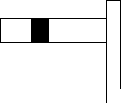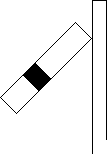|
|
|
|
|
|
Where the sighting of a signal is compromised by track curvature or an intervening overbridge or station canopy, etc., an extra signal may be installed to give drivers of approaching trains an earlier view of the indication shown. A driver who was expecting to find the signal at 'danger' but receives early information that the signal has cleared can accelerate sooner, providing a benefit to train running performance. Duplicate signals installed at the same longitudinal position are termed 'co-acting' signals, whereas an additional signal provided at a different longitudinal position from the signal it repeats is known as a 'repeater' signal.
Where co-acting semaphore signals were provided, the duplicate arms were usually mounted at different heights on the same post [7.1]. In some examples, only the lower arms had lamps, and in some cases, not every arm was duplicated [7.2]. Exceptionally, the duplicate signals were positioned on the opposite side of the line [7.3] or the arms may be arranged differently [7.4].
| * Note: | The illustrations above serve only to show the positions of the signal arms, which are described in Section 2. |
The most impressive array of co-acting signals ever seen first appeared on the London & North Western Railway in 1895. The Manchester, Sheffield & Lincolnshire Railway's new London Extension line was to cross over the existing LNWR line on a new bridge at the south end of Rugby station. Prior to the bridge's construction, it was realised that the complex background it would introduce would have an adverse effect on the sighting of the three adjacent Down lines' signals on the approach to the LNWR station. The LNWR therefore erected an enormous two-level gantry on which all twenty-two semaphore arms (thirteen stop arms and nine distant arms) were duplicated at different heights. The MS&LR paid for the work. On account of its appearance, the gantry became known as "the Rugby Bedstead". It was removed in 1939 and replaced by three colour light signals.
Slip carriage working involved detaching the rear portion of a passenger train while it was in motion, enabling passengers to alight at an intermediate station without the whole train stopping. After being detached, the slip guard operated the brakes on the slip portion to bring it to a stand at the station, while the main train continued on its journey. Slipping would not take place if the train had to stop because of adverse signals, thus the slip guard needed to observe the distant signal on the approach to the station to determine whether the slip portion could be detached. At certain places on the Great Western Railway where the distant signal could not be easily seen by the slip guard, a repeating distant signal was fixed lower on the post. These slip distants had a similar appearance to a normal semaphore distant arm but were reduced in size or length.
Repeater signals originally took the form of specially distinguished semaphore signals [7.5 - 7.10] that worked in conjunction with the signal beyond to which they referred. A train that approaches a repeater signal in the 'on' position is not required to stop at it and is authorised to pass the repeater signal and draw up to the main signal beyond.
 |
 |
|
[7.5] Semaphore Repeater Signal ('on').
Area: Unknown Usage: Unknown Status: Historical |
[7.6] Semaphore Repeater Signal ('off').
Area: Unknown Usage: Unknown Status: Historical |
|---|---|
 |
 |
|
[7.7] Semaphore Repeater Signal ('on').
Area: LB&SCR Usage: Unknown Status: Historical |
[7.8] Semaphore Repeater Signal ('off').
Area: LB&SCR Usage: Unknown Status: Historical |
 |
 |
|
[7.9] Semaphore Repeater Signal ('on').
Area: L&SWR Usage: Unknown Status: Historical |
[7.10] Semaphore Repeater Signal ('off').
Area: L&SWR Usage: Unknown Status: Historical |
At some places (typically at the end of a station platform) where trains were required to stop so close to a main semaphore signal that its arm could not be easily observed, a co-located ground shunting signal (see Section 4) was provided to act as a repeater for short-range viewing. A yellow shunting signal may be used in cases where the close-up repeater signal was located slightly on approach to the main signal.
At Aberdare (High Level) on the Great Western Railway, there was a rare example of a repeater for a backing signal. The arm of the repeater was similar in appearance to that of an ordinary backing signal (see [4.26 & 4.27]) except that it had a fishtail in the end [7.11 & 7.12].
 |
 |
|
[7.11] Distant Backing Signal ('on').
Area: Aberdare, GWR Usage: Low Status: Historical |
[7.12] Distant Backing Signal ('off').
Area: Aberdare, GWR Usage: Low Status: Historical |
|---|
Banner type repeater signals began to appear following the patenting of an improved design of banner signal by the W R Sykes Interlocking Signal Co. in 1909. Since banner signals with red arms were already being used as main signals (see [2.70 - 2.73]) and shunting signals (see [4.37 & 4.38]), it was necessary to specially distinguish those that were to function as repeaters. On the London, Brighton & South Coast Railway, this was achieved by endorsing the face of the signal with a letter "R" [7.13 & 7.14]. If repeating a distant signal, a fishtail notch was cut into the left-hand end of the arm [7.15 & 7.16].
 |
 |
|
[7.13] Banner Repeater with Red Arm ('on').
Area: LB&SCR Usage: Unknown Status: Historical |
[7.14] Banner Repeater with Red Arm ('off').
Area: LB&SCR Usage: Unknown Status: Historical |
|---|---|
 |
 |
|
[7.15] Fishtailed Banner Repeater with Red Arm ('on').
Area: LB&SCR Usage: Unknown Status: Historical |
[7.16] Fishtailed Banner Repeater with Red Arm ('off').
Area: LB&SCR Usage: Unknown Status: Historical |
In July 1916, the London & South Western Railway installed colour light repeaters on the platform roads at Waterloo. These showed a red light when 'on', and a green light when 'off'.
At a few locations, electric light fog repeaters were provided. The lights in these signals were normally extinguished, being exhibited only when fog or falling snow caused poor visibility conditions. The fog repeaters installed on the Ealing & Shepherd's Bush Railway (GWR) in 1920 displayed an orange aspect [7.17] if the signal being repeated was at 'danger', or a green aspect [7.18] if the signal was at 'caution' or 'clear'. The words "fog repeater" were written on the face of the repeater, as was the number of the signal to which it referred.
 |
 |
|
[7.17] Fog Repeater ('on') (e.g. refers to signal number S81).
Area: Ealing & Shepherd's Bush Railway Usage: Medium Status: Historical |
[7.18] Fog Repeater ('off') (e.g. refers to signal number S81).
Area: Ealing & Shepherd's Bush Railway Usage: Medium Status: Historical |
|---|
By 1922, the Great Northern Railway was using semaphore repeater signals comprising a yellow 'somersault' type arm endorsed with a letter "R" [7.19 & 7.20].
 |
 |
|
[7.19] Semaphore Repeater Signal ('on').
Area: GNR Usage: Unknown Status: Historical |
[7.20] Semaphore Repeater Signal ('off').
Area: GNR Usage: Unknown Status: Historical |
|---|
|
|